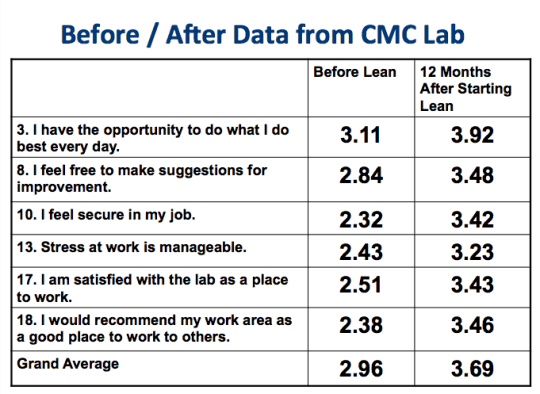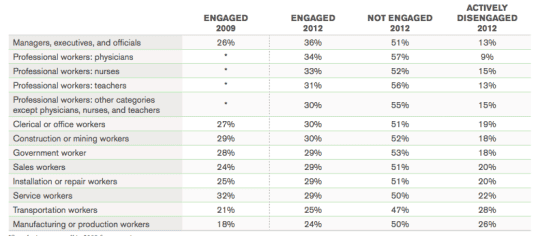 It's always sad then these national employee engagement surveys come out… the latest one from Gallup doesn't paint a pretty picture: “Most workers hate their jobs or have ‘checked out,' Gallup says.”
It's always sad then these national employee engagement surveys come out… the latest one from Gallup doesn't paint a pretty picture: “Most workers hate their jobs or have ‘checked out,' Gallup says.”
It's also far too easy for employers or leaders to blame the employees for being disengaged or disgruntled.
As the late, great Peter Scholtes asked, “Why do you hire dead wood? Or why do you hire live wood and kill it?”
From the article:
The survey classifies three types of employees among the 100 million people in America who hold full-time jobs. The first is actively engaged, which represents about 30 million workers. The second type of worker is “not engaged,” which accounts for 50 million. These employees are going through the motions at work.
The third type, labeled “actively disengaged,” hates going to work. These workers — about 20 million — undermine their companies with their attitude, according to the report.
So 70% are “going through the motions” or actively “undermining” their employer. Sad. Read the Gallup report here (and their blog post about it).
From the report, about healthcare workers:
Gallup also finds professional workers at the higher end of the employee engagement spectrum, possibly because these jobs are more likely to reflect workers' talents and interests. Healthcare professionals are slightly more engaged than other professionals. Notably, far fewer physicians are actively disengaged than any other category of workers.
Gallup says people WANT to do something about low engagement, but don't know how:
“The general consciousness about the importance of employee engagement seems to have increased in the past decade,” said Jim Harter, Gallup's chief scientist for workplace management and well-being. “But there is a gap between knowing about engagement and doing something about it in most American workplaces.”
One way to close this gap, to improve employee engagement, is to embrace the “kaizen” style of continuous improvement or to adopt a truly “Lean culture,” perhaps patterning off of the Toyota Way management system and its dual pillars of “continuous improvement” and “respect for people.”
I'd love to see a survey of full-time Toyota employees to see how their levels of engagement or disengagement compare to the general public. What about your Lean organization?
In the first year of their Kaizen and daily Lean management approach in the lab at Children's Medical Center Dallas, employee engagement scores went up pretty noticeably (in all areas, not just the survey questions shown below, on a 1 to 5 scale, with 5 being the highest score):

It wasn't magically turned into a perfect environment after a year, but they kept working at it. They've now been practicing Kaizen for about six years (as highlighted in my book Healthcare Kaizen). Our KaiNexus customers are better engaging their employees and leaders in ongoing continuous improvement, as well.
- After actively using KaiNexus for a little over a year at the University of North Carolina Health Care System, overall staff satisfaction improved by 25% and staff felt 50% more likely to bring forward improvement ideas (based on an anonymous before and after survey).
Ironically, many skeptics think that Lean somehow creates a dehumanizing environment because it comes from manufacturing (which only goes to show they don't yet understand Lean Manufacturing or Lean Management, more generally).
I recently saw this on a Toyota website:
Within the Toyota Production System, Kaizen humanises the workplace, empowering individual members to identify areas for improvement and suggest practical solutions.
In a Kaizen environment, leaders connect better with employees. They connect what people are doing every day with a strong sense of mission and purpose. Leaders make a commitment that Lean and Kaizen won't lead to layoffs. They ask employees for ideas that can make their work easier and more fulfilling, by figuring out better ways to take care of patients (or customers in other industries). Kaizen and Lean lead to more engaged employees and happier employees.
What describes the engaged workers?
- “they know what is expected of them
- they have the tools to do the job right
- they have the opportunity to do their best every day
- they believe their opinions matter and
- they have opportunities to learn and grow.”
That sounds like a Lean environment, to me.
More from the ajc.com article:
The good news is there are more engaged workers since Gallup's last survey in 2010, if only 2 percentage points more. The bad news there are still plenty more workers who are either not engaged in their work or are actively disengaged, and that's because they have poor managers, [Gallup CEO Jim] Clifton said.
In the report, the CEO said “having too few engaged employees means our workplaces are less safe, employees have more quality defects, and disengagement — which results from terrible managers — is driving up the country's healthcare costs.”
The two percentage point increase could just be noise in the data, of course. It could drop three points next year without meaning anything in the underlying system has changed (read more about this in a post about SPC and data analysis).
As Clifton was implying, impact of low engagement goes beyond unhappy employees. We know in healthcare that better engagement leads to better patient care, better quality, and lower costs.
You can also look at the seven tips for better engagement from Carmine Gallo in this Forbes article: “Seven Ways To Inspire Employees To Love Their Jobs.”
As Dr. Deming was quoted as saying, “…if management stopped demotivating their employees then they wouldn't have to worry so much about motivating them.” If the “prevailing system of management” (as Deming called it) wasn't so demoralizing, we wouldn't have to spend as much time inspiring them. But, Gallo makes some good points, including”:
Most of these disengaged employees are looking for inspiration. They are searching for meaning and they want to have someone or something to believe in. They want to make a difference and they're looking to you—their team leader—for inspiration.
Like Gallo says, some people are just in the wrong jobs or careers. But, we need to work with the vast majority of employees, providing better leadership, rather than just writing them off as disgrunted.
Here is a table, from the Gallup report, comparing nurses, physicians, factory workers, and other professions (click for a larger view):
The bottom row implies that not all manufacturers are “Lean manufacturers,” with such high disengagement scores.
What do you think? Please scroll down (or click) to post a comment. Or please share the post with your thoughts on LinkedIn – and follow me or connect with me there.
Did you like this post? Make sure you don't miss a post or podcast — Subscribe to get notified about posts via email daily or weekly.
Check out my latest book, The Mistakes That Make Us: Cultivating a Culture of Learning and Innovation:











Agree with you, Mark, that the lean culture and Kaizens are well suited for improving employee engagement. They’re designed to respect people, involve them in meaningful thinking and actions and work together to make improvements.
Also thank you for introducing me to the late, great Peter Scholtes. I’ve read his quotes for years, yet never knew who was behind them. So original and pithy! I’m sure you’d never catch him using the clichés carrots and sticks and steroids!
For more on the connection between Lean management and human health, have a look at my e-book, Lean IS Healthcare http://www.bobemiliani.com/lean-is-healthcare/
Great article. Kaizen when done correctly can help in so many ways. The main take away I got was “if management stopped demotivating their employees then they wouldn’t have to worry so much about motivating them” This is very true sometimes even with this you still have those employees that are dead weight.
Why is somebody “dead weight?” Or, as Scholtes said, “dead wood?” Were they “dead weight” when they were hired? Probably not…
I don’t know, Mark. No disrespect intended, but I’m not sure I agree.
I’m not sure a kaizen approach can be applied to all employment scenarios–manufacturing, sure. Healthcare, why not? But, I think employers who actively seek to have engaged, happy employees will rub off on their employees’ attitudes just as much as trying t organize their working environment will.
Pay them what they’re worth and give them respect and praise. If you treat workers like sheep or cattle, don’t be surprised if they allow their brains to adjust to their demands.
Jason – what are you disagreeing with? It’s fine to disagree…
In what environments do you suspect Kaizen would not work?
Jason I agree with your statement regarding getting paid what one is worth and praise. However since the bottom line is the main focus and reducing costs is a constant mandate you can’t have it both ways
I have to agree with the statement about Toyota humanizing the workplace as, at least partially, a “fix” of sorts. But even that step is not going to be enough,long term, if the Leadership is not in a position to truly lead and inspire.
To Lead = to point the worker/employee/team in a direction of growth and purpose and clearly “paint” a picture of the goals and (meaningful) rewards, for moving in that direction.
I digress, but again, an enlightened workforce, in my books, requires an enlightened leader. I have been blessed to have experienced this a few times in my life – ironically in an automotive group that owned several Lexus dealerships!
Sorry, let me explain a bit more: I’m thinking it’s something a bit more ingrained with the workplace heirarchy. It’s the ever-growing chasm between the “higher-ups” and the working person. As salaries increase for those at the top, and wages decrease amongst the working masses, the attitude is that of “checking out” or undermining as a defense. It’s this idea that “I might not be here tomorrow, so why should I give a flip?”
I think it’s something that no management style can totally eradicate upon its own merits. It has to include a leveling of the playing field and a return to having respect and appreciation for workers–which will, in turn, give the worker respect for themselves and the work they are doing.
Thanks for elaborating. I don’t think we’re in disagreement at all, Jason. If employees fear being laid off or they resent their CEO because of an outrageous pay package, that hurts morale and it’s unlikely Kaizen participation is going to happen.
Having respect for workers at all levels, demonstrated by senior leaders and all leaders, is necessary. I’ve also written about hospitals that have some variation of a “no layoffs due to Lean” policy or philosophy.
See article link
[…] I couldn’t agree more. Read his post here: https://www.leanblog.org/2013/06/most-workers-hate-their-job-are-disengaged-lean-can-help/ […]
[…] Recent research seems to indicate that a significant percentage of American workers just plain don’t like their jobs. Help can be found in some unexpected places. Mark Graban on his Lean Blog explains the connection between Lean and job satisfaction in his latest article. Check it out HERE. […]